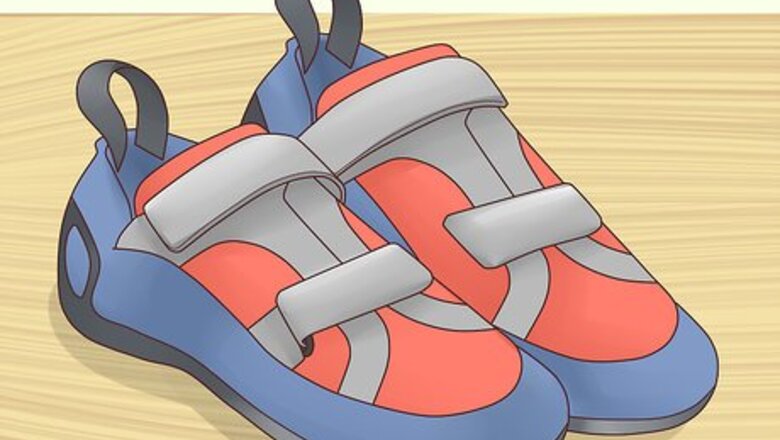
views
Practicing the Technique

Buy shoes with plenty of rubber in the heel. The more rubber in the heel, the easier it is to pull off the heel hook. The extra rubber gives you a larger surface area for grip and also allows for a wider range of body movement once your heel is planted. Some shoes will have grooves and edges built in to provide extra grip for the heel hook. Tighten your shoes as much as you can before trying to pull off the heel hook. The last thing you want to happen is for your foot to slip out of the shoe.
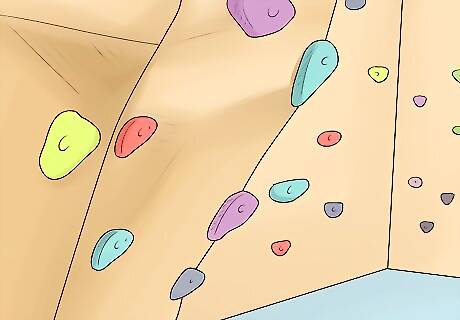
Look for a place to put your heel to maximize surface contact. The heel hook is a move that turns your leg and foot into another arm and hand. By practicing at the gym, you can perfect the move before you use it outside in a climb. Look for bumps or dips to place your foot in on the climbing wall at the gym. Accuracy is a vital aspect of the heel hook technique. If you choose a spot to aim for, make sure it's a spot you'll be able to hit.
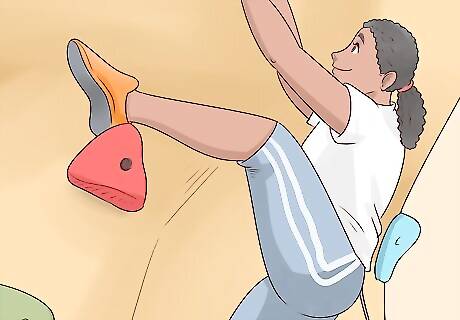
Place your heel in the spot and keep your hips close to the wall. Stretch your heel towards the spot you picked when you examined the wall. By keeping your hips close to the wall, you increase your range of movement. When ready, engage your abdominal and leg muscles and pull your heel toward your butt.
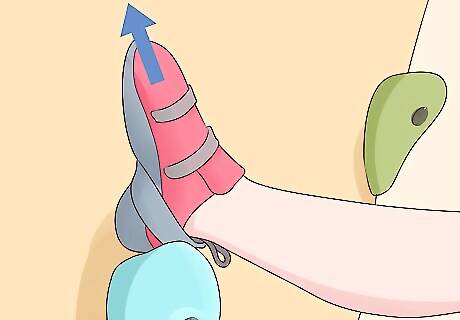
Point your toes to help you stay stable in the heel hook. Once you feel like your heel is solidly placed in the spot you chose, plant your heel and pull harder with it. It's vital that you feel confident in the grip your heel has before you make the move. If you don't feel confident in the move, back away. Think of your heel and leg like a hand and arm.

Plant your other foot on another spot to act as a point of support. When you release your heel from the heel hook position, you will feel a rapid loss of tension and pressure throughout your body. By planting your other foot, you support your body and allow for a smooth transition of your weight back to your hands. Keep your core as tight as you can for as long as possible. Core tightness is a vital part of this move.
Choosing When to Use the Heel Hook
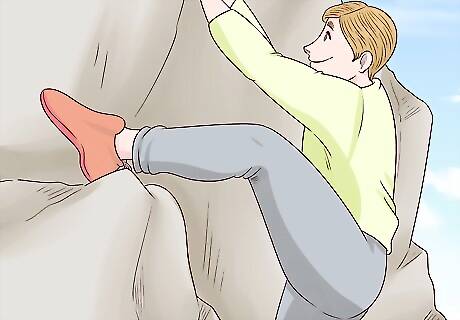
Perform the heel hook to advance up the rock or terrain. The chief use of the heel hook is to help you make a quick move upwards in your climb. By planting your heel in a certain spot, you can use it to move upwards and free up one of your hands to reach for a higher point. Remember that pressure is a vital part of the heel hook, even more so when you're moving upwards. Make sure that the spot you pick to plant your heel is solid enough to hold your body weight and extra pressure.

Use the heel hook to give your hands and arms time to rest. You can also use the heel hook to give your arms time to recover from the stresses of the climb. Make sure the spot you choose to plant your heel is secure. Ensure you have a good enough grip with your heel as well. When ready, plant your heel and move up. Leave your heel in the hook position for a few seconds while you let your arms recover. Shake your arms and hands as they recover.
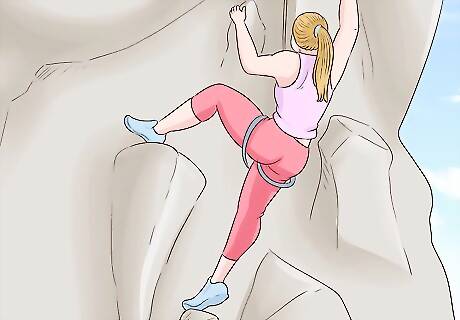
Execute the heel hook to stabilize your body. You don't need to use the heel hook to make big movements all the time. You can also use it to get your balance back and give you some time to plan your next move. Plant your heel in a suitable spot and analyze the rock above you before you move. If your hands are busy and you can't use them to test the spot you want to plant your foot in, try and kick it with your foot. If the spot doesn't break or move, you can use it for the heel hook.
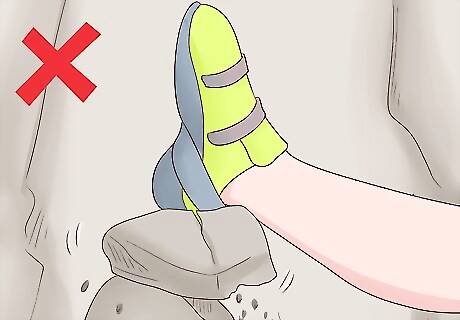
Avoid using the heel hook if your chosen spot isn't strong enough. If you've tested the spot beforehand and you're doubting if it can hold you, don't try and use it for a heel hook. A weak jut or ledge can break and you will either fall or injure yourself when it breaks under the pressure of your heel. Only perform the heel hook when you are certain the rock can support you.
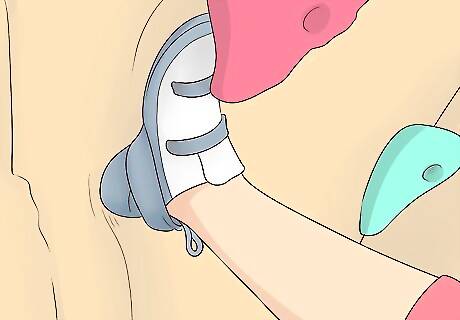
Utilize a toe hook if a heel hook isn't possible. Toe hooks are similar to heel hooks in what they are used for. If you can't use a heel hook, a toe hook can be used instead to achieve the same goal. Instead of planting your heel, you'll need to pull with the top of your foot. Toe hooks are best used in gaps in the rock or when you can slide your foot under a jut or ledge and use it to support your foot.
Improving Leg Strength for Heel Hooks
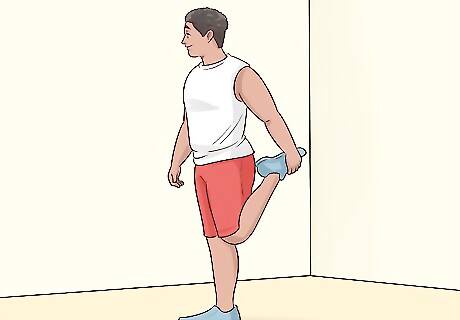
Stretch your legs before working out to prevent injury. Stretching your legs will help reduce injury by eliminating stiffness from your muscles and joints. If you don't stretch before you work out, you increase your chances of injury and you will get less benefit from your workout. Some leg stretches are: Quad stretch. Stand upright and lift your left leg up towards your butt. Grab your left ankle with your left hand and hold it for 10 seconds. Switch and do the same with your right leg. Hamstring stretch. Stand upright again. Move your left foot slightly forward and point your toes toward the ceiling. Place your hands on your hips and bend down into the stretch. You should feel a tightness in your left hamstring. Switch and do the same exercise with your right leg. Inner thigh stretch. Stand with your legs wider than shoulder width. Turn toward your left side and bend your left knee, keeping your right leg straight. Lean toward your left side and feel the stretch in your right inner thigh. When finished, replicate the same exercise on your right side.
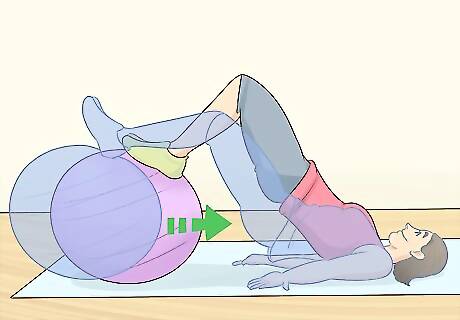
Strengthen your hamstrings with stability ball hamstring curls. Lie on the floor with your feet on top of the stability-ball. Place the ball in a position that allows you to extend your ankles on top of the ball. From this position, lift your hips off the floor, keeping your weight on your shoulders and feet. Bend your knees and bring the ball as close to you as possible, contracting your hamstrings. Return to the starting position. Repeat this exercise by doing 4 sets of 10 reps to build your hamstring strength.

Do squats and deadlifts to build leg strength. These exercises are used by climbers all over the world to build strength in their legs and core. You can do both squats and deadlifts with no weight and just the bar. Using a weight will increase leg strength much faster than using just the bar. To perform a squat, start with a wide stance. Keep your back straight throughout the exercise. Push your butt out while keeping your eyes, head, and chest up. Do 3 sets of 10 repetitions. To execute a deadlift, use a wide stance. Keep your arms straight as you can and lift with the bar close to your shins. Don't lift the bar above knee height. Do 3 sets of 10 repetitions for this exercise as well.

Perform a calf raise to increase your calf strength. Find an area slightly elevated above the ground like a curb or step. You can also stack a couple of heavy weights on top of each other. Stand with the balls of your feet on the edge of the step and the heel of your foot hanging off the edge of the step. Drop the heels of your feet until you feel a stretch in your calf. Then use pressure on the balls of your feet and toes to stand up into a tip-toe position. Hold a weight in your hands to make the exercise a little more difficult. To improve your balance for climbing and the heel hook, do the exercise with one leg at a time.

Use wall sits to strengthen all the muscles in your legs and your core. Wall sits are one of the most hated leg exercises by people everywhere. However, they are a fantastic exercise for climbers as they strengthen every one of your leg muscles. Sit against a flat wall with your back straight and your legs at 90 degrees. Fold your arms or place your palms flat against the wall behind you. Try and do 5 repetitions of 30-second long wall sits. The stronger your legs get, the more time you can add to the wall sit and the more repetitions you can try.















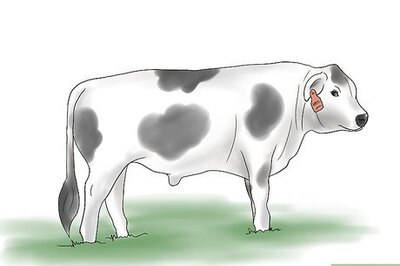
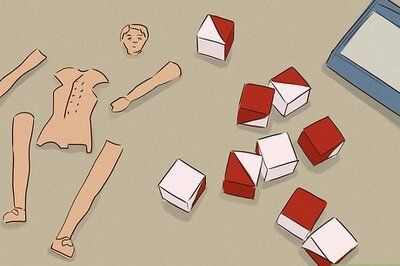
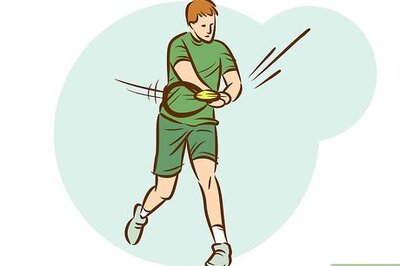

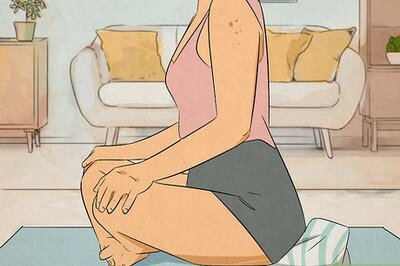
Comments
0 comment